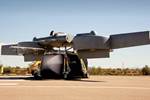AMD receives DASA funding for U.K. unmanned air system competition
AMD will incorporate existing low-cost radar absorbing material technologies to advance autonomous air systems.
Nanotechnology company Advanced Material Development (AMD, Guilford, U.K.) has received U.K. government Defence and Security Accelerator (DASA) funding within the new “Affordable and Adaptable Unmanned Air Systems” competition.
Funded by the Army Research Innovation and Exploitation Laboratory (ARIEL), a part of the Army’s Futures Directorate, the competition seeks novel, low-cost and adaptable autonomous air system development for the U.K. The challenge for AMD is to use its existing low-cost radar absorbing technologies to help such autonomous air systems survive against evolving counter-air and counter-uncrewed air system threats.
“We are excited to be working within this program offering the U.K. government an opportunity to exploit AMD’s existing radar absorbing technologies that have been developed over the last 5 years,” John Lee, CEO of AMD, says. “We fully expect to be able to demonstrate that AMD materials will, without any other negative impact, provide a significant broadband reduction in the radar cross-section of the platform.”
AMD creates ultra-lightweight, cost-effective and sustainable advanced sensors and electronic devices via its multifunctional materials platform, which can be integrated into coatings, plastics, composites and foams. The company is addressing challenges across multiple sectors, including defense, industrial, consumer and life sciences.
Related Content
-
Farnborough Airshow 2024 brings together aerospace innovation, collaboration
The week-long international airshow provided a hub for new announcements made by Boom Supersonic, Airbus, Boeing, GKN, GE, ZeroAvia, Eve, Bell, VoltAero, Eve and Lilium. CW has compiled several below.
-
TenCate Advanced Armour renamed to Integris Composites
With its rebranding, Integris maintains the ability to develop, test and manufacture ballistic armor and survivability solutions while expanding into new markets where composite solutions can be advantageous.
-
Montana State researchers introduce novel method for “stretch-broken” carbon fiber
New stretch-breaking concept consistently produces carbon fiber that is eight times more formable with strength equivalent to continuous fibers, enhancing its prospects to form to complex aircraft shapes and cut manufacturing costs.













.jpg;maxWidth=300;quality=90)
